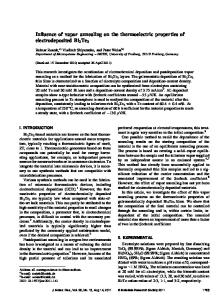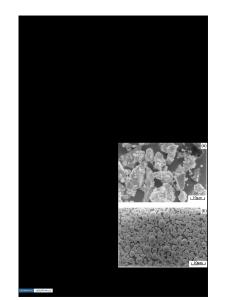The Effect of Bi Addition on Thermoelectric Properties of the Sintered Heusler Fe 2 VAl Alloy
- PDF / 5,186,532 Bytes
- 6 Pages / 612 x 792 pts (letter) Page_size
- 62 Downloads / 335 Views
1044-U06-09
The Effect of Bi Addition on Thermoelectric Properties of the Sintered Heusler Fe2VAl Alloy
Masashi Mikami1, Keizo Kobayashi1, Kiminori Hazumi2, and Yoichi Nishino2 1
National Institute of Advanced Industrial Science and Technology, Nagoya, 463-8560, Japan
2
Nagoya Institute of Technology, Nagoya, 466-8555, Japan
ABSTRACT A Fe2VAl0.9Si0.1/Bi composite were fabricated using pulse-current sintering technique with mixed powder prepared by mechanical alloying. Since the raw powders were finely pulverized into nanometer sized crystallite and rapidly sintered to suppress grain growth during heat treatment, microstructural composite was obtained. The composite was consisted of Fe2VAl0.9Si0.1 grains with the size of 200-300 nm and nanometer-sized Bi particles. The size of the Bi particle decreased with the increase in the milling processing time, while the size of the Fe2VAl0.9Si0.1 grains showed no variation. The thermal conductivity of the composite decreased with the reduction of the Bi particle size, because of the increase in the number of hetero junction, at which phonons were scattered. On the contrary, the electrical conductivity was less affected by the incorporation of nanometer-sized Bi particles. This means that the hetero junction between Fe2VAl0.9Si0.1 and Bi has little effect on the carrier traveling or the dispersion of highly conductive Bi particles enhanced electrical conductivity. Although Seebeck coefficient was reduced by a negative effect of Bi incorporation on the Fe2VAl0.9Si0.1 crystal structure, the introduction of Bi nanoinclusions in the sintered Heusler material was effective to reduce the thermal conductivity without degradation of electrical conductivity and consequently improved the thermoelectric figure of merit. INTRODUCTION Thermoelectric devices have recently attracted renewed interest for their potential application in clean energy-conversion systems. Especially, vast amounts of low-temperature waste heat, such as that below 500 K, are targeted for thermoelectric power generation because such low-temperature heat energy is difficult to reuse with other energy conversion systems. The conversion efficiency of a thermoelectric device depends mainly on the material’s thermoelectric properties, which are evaluated using the thermoelectric figure of merit Z (= S2σ/κ, where S is the Seebeck coefficient, σ is the electrical conductivity, and κ is the thermal conductivity). A Heusler alloy, Fe2VAl, is a promising candidate for thermoelectric power generation near room temperature because of its high thermoelectric power factor PF (= S2σ, which is used to estimate the power generation ability of material) [1], which is comparable to conventional thermoelectric materials, such as Bi-Te alloy. In a Fe2VAl system, σ and S are enhanced simultaneously by the off-stoichiometry of Al content or the element partial substitution, such as Si or Ge for the Al site
and Ti for the V site [1–5]. The PF value reaches 5.4 × 10-3 W/mK2 at 300 K [1]. In addition, because of its high mechanical st
Data Loading...











